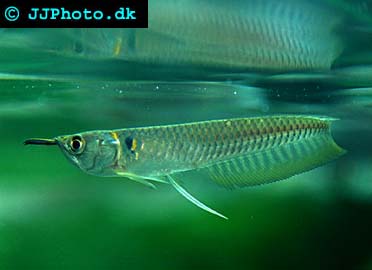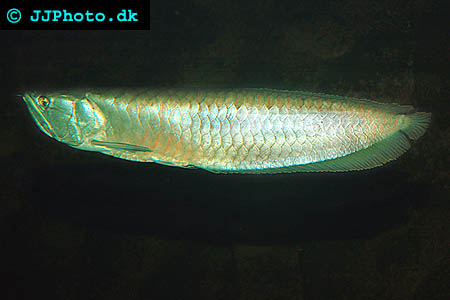Silver Arowana
The Silver Arowana is of the genus “Osteoglossum bicirrhosum,” were recognized as a new fish species in 1829 in France, by zoologist Georges Cuvier. They are classified as Bony-Tongued Fish which are fish that go back to somewhat pre-historic times. In fact, in Greek, Osteoglossum is bone-tongued and bicirrhosum is "two barbels.”
Silver Arowana are found naturally in white and black water floodplains of South America in the freshwaters of the Amazon River Basin and River, maybe in the Rupununi and Oyapock Rivers, and in some still waters of Guyana as well. There is indication that they don’t go through rapids, as they haven’t promulgated further upstream. Most of the Silver Arowana are found in the swamp and flooded areas in the shallower water.
Silver Arowana are primitive, prehistoric fish. They actually have teeth on their tongue that comprise the bite they have for their food. Other relatives of Arowana in general include the Butterfly fish and Elephant fish.
Silver Arowana are among the cheapest Arowana available, and the least restricted to import/export. They come small, but look out, they grow rapidly. It is wise to get them at 4-8 inches/ 10-20cm when they are hardier and easier to handle. This will give you a better chance of success keeping them.
The natural environment of the Silver Arowana is from about 75 to 82 degrees F (24-28 C) warm in the water. In the wild, Silver Arowana may reach upwards of 4 feet /120 cm in length, and a little over ten pounds in weight.
They require good water condition to flourish. You must keep Ammonia and Nitrites close to zero. Silver Arowana create a lot of waste, so the filtration system needs to be strong and efficient. Changing at least 25% of the water per week is advisable. Some even recommend as much as 50-75%. The pH of the water (soft and acidic) is best kept between 6.0 and 6.9. Water hardness level for an ideal environment is about 1-8dH.
Their body are covered in very big, strong, and bony scales, and at the lower jaw, 2 barbels. Silver Arowana have a large, bony tongue. The dorsal and anal fins are nearly connected to the caudal fin. Adult Silver Arowana is silvery usually whereas the juveniles often have a yellow-orange bar on the side. They have longer fins than the other Arowana species from Australia, Asia, and Africa.
The growth rate in the Silver Arowana is about two inches (5cm) a month during their first year.

Juvenile Silver Arowana - Osteoglossum bicirrhosum.
Copyright www.jjphoto.dk
Silver Arowana requires a larger aquarium tank that needs to be well covered to prevent the fish from jumping out if the aquarium to their deaths. The size required depends on the size of your Arowana but should as a rule be at least twice and preferable more than 3 times the length of the fish. Decorated the aquarium so that a lot of open space is created to allow your Silver Arowana fish space where they can swim freely. Silver Arowana like their space to move about in (above). You will however probably want to give them a couple of places where they can hide. While some tank mates may be good for dinner, you might try some other large fish that are hardy and slightly aggressive fish such as Catfish to keep with your Arowana.
Silver Arowana fish demands a varied diet. They are usually fed guppies in the stores where they are sold and whatever it takes upon acclimation to get them to eat other things is wise and necessary to get them to do so. Getting them to eat non-live food can be a good thing too, as it expands your options for variety. They will usually eat things such as frozen raw shrimp, squid, scallops, and fish fillets. They will also accept a number of live foods such as, smaller fish, plankton, crickets, bloodworms, other insects, and mosquito larvae. If trained, they will eat nearly anything they can get their hands on. Goldfish might be suggested as a snack, however they should not make up a too large part of your Silver Arowana’s diet. Another aspect, if you dare, is to attempt to get them to fetch food from your hand which can result in some painful bites until the Arowana learns it.
One condition that is often seen in Silver Arowana is called “Drop Eye”, where an eye appears to look downward. It seems this may be the result of over breeding at the breeders though it might also come from fatty tissues behind the eye. Less fat in their diet may help to minimizing or preventing this.
Make sure the top of your tank is well secured. Silver Arowana are Jumpers, and may wind up dead on the floor otherwise.
They can be shy, and easily spooked. For example, when turning on the lights, it is wise to turn on the room lights first. Then after a few minutes, turn on the tank lights. Otherwise, your Silver Arowana might get spooked and injure itself. It is good if you can get some sunlight to them in the day as well, but not constant or you might wind up with an algae problem.

Adult Silver Arowana - Osteoglossum bicirrhosum.
Copyright www.jjphoto.dk
It is suggested for filtration to use adequate Mechanical, Chemical, and Biological filtration to cover the amount of water in the tank. Multiple units might not hurt considering the volume of water you need for your Silver Arowana, and it does provide backup in case one system fails.
On a closing note, you should also remember, Silver Arowana’s are not for the poor, or the inexperienced aquarist. However, they are very interesting fish to watch grow, and live. They will undoubtedly give you many hours of enjoyable scenery, and experiences. If you choose to get a Silver Arowana, it is wise to do a lot of research to become even more experienced with these great living examples of the Amazon Basin.
Didn't find the info you were looking for? Ask your question in our Aquarium forum !
Our knowledgeable staff usually responds to any question within 24 hours
Predatory fish articles
Alligator Gar - An article about Alligator gars in the wild, and some of the treats to the alligator gar population.
Arapaima fish - An introduction to Arapaima fish, also know as pirarucu
Arowana fish - An article about Arowana fish
Asian Arowana - An article about the asian arowana
Asian Snakehead Fish - An introduction to Asian Snakehead fish
Bichirs - Information about Bichirs
Black piranha - Information about the Black piranha
Breeding Bichirs - Information about Breeding Bichirs
Breeding Piranhas - a short review - a short review
Channa aka frankenfish - Information about Channa aka frankenfish
Channa bleheri / The Rainbow snakehead - Channa bleheri.
Datnoids - Information about Datnoids, also known as dats and siamese tigers
Environmental effects of Snakeheads - Information about the Environmental effects of Snakeheads
Freshwater Moray eels - keeping freshwater Moray eels
Freshwater Pufferfish - Information about different species of freshwater pufferfish
Freshwater Sawfish - An introduction to freshwater swordfish and their present endangered status.
Keeping Gars - A short review - Basic Gar trivia
Keeping Pirhana fish (piranha) in aquarium - Information about Keeping Pirhana fish in aquarium
Keeping Snakeheads in Aquariums - Information about Keeping Snakeheads in Aquariums
Lung fish - Information about Lung fish
Needlefish - An introduction to Needlefish
Payara – Vampire Fish - Information about Payara – Vampire Fish
Piranha keeping for Beginners - Different species of Pygocentrus and Serrasalmus are commonly kept. Their characteristics, tank and living requirements,
Pirhana - Information about Pirhanas
Porcupine puffer fish - An introduction to Porcupine puffer fish
Pufferfish - An introduction to Pufferfish.
Snakehead fishing - Information about Snakehead fishing
Snakeheads - Information about Snakeheads
Toadfish - An introduction to Toadfish
